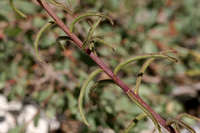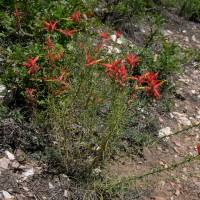|
|
 Leaves Patrick Alexander @http://swbiodiversity.org, Usage Rights: Creative Commons Attribution-ShareAlike (CC BY-SA) |  Plants Max Licher @http://swbiodiversity.org, Usage Rights: Creative Commons Attribution-ShareAlike (CC BY-SA) | | | | |
|
Origin:
Native
Life Cycle:
Perennial
General Desc:
Woody based, semi-parasitic, few to many smooth to slightly hairy stems and very narrow yellow to grayish-green stalkless leaves. The torch-like clusters at the stem tips consist of showy red petal-like bracts often mistaken for actual flower petals.
Identification notes: Stems several to many; leaves narrow with smooth margins; flower bracts deeply incised or pinnatifid; bracts and flowers light red, beaks bright green.
Height:
To nearly 3 feet
Habitat Description: Found on dry plains, in open woods, on rocky slopes, in areas of sagebrush scrub and grasses, in pinyon-juniper woodland communities and in Ponderosa pine, spruce-fir forests and aspen-conifer zones.
Plant Communities:
Interior Chaparral, Semidesert Grasslands, Pinyon Juniper Woodland, Montane Conifer Forest
Elevation: 5000 - 10000 feet
Color:
Red, bright green
Shape:
Irregular in elongated clusters
Tubular:
Y
Flowering Period:
Apr - Oct
Description:
The torch-like flower stalk is a showy, dense, terminal cluster 3 to 6 inches long. It consists of petal-like bracts whose upper sections are red and lower sections green. Extending from the bracts are the bright green tips (beaks) of the red flowers.
Leaf Color:
Yellow, grayish-green, purple
Leaf Type:
Simple
Leaf Shape:
Narrow
Leaf Margin:
Smooth
Leaf Attachment:
Alternate
Leaves Clasp:
N
Hairs:
Stems
Spines:
N
Leaf Description:
Stems are often branched but may be unbranched. Stems and leaves are yellow to grayish-green turning purple with age. Leaves are very narrow with 0 to 3 lobes usually on the upper leaves, up to 3 inches long, with leaf margins that fold upward.
Fruit Color: Brown
Fruit Type: Capsule
Fruit Notes: Fruits are dry, asymmetrical, egg-shaped capsules, 1/2 inch to 3/4 inch long, with 2 to 4 segments or divisions. They produce many small seeds that are released upon maturity at which time the fruit segments split lengthwise.
Seed Notes: The seed is brown with angled-edges, about 1/16 inch long with a net-like or criss-cross pattern on its surface. The outer covering of the seed is loose-fitting and attached at the base of the fruit.
|
|